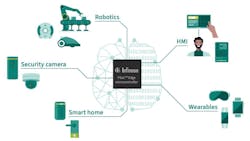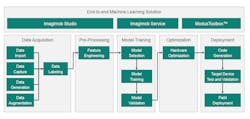PSoC Rides on the Edge
This article is part of the TechXchange: AI on the Edge.
What you’ll learn:
- Why a PSoC and AI form a great edge combination.
- What the PSoC architecture brings to the table.
Infineon’s long line of PSoC configurable microcontrollers have recently been based on Arm Cortex-M4, Cortex-M3, and Cortex-M0+ cores. What sets the PSoC line above stock Cortex-M microcontrollers is the configurable digital and analog components. This puts it between the stock parts and an FPGA. FPGAs are much more configurable, but they’re usually more power-hungry. Configuring them is much more difficult, too.
PSoC Creator, Infineon’s software, is used to configure the digital and analog blocks. These blocks are in addition to the fixed analog and digital components. The configurable components can handle things like custom serial interfaces or analog front ends that can offload the host providing lower-latency functionality. Specialized blocks such as MagSense for metal detection and CAPSENSE for capacitive-touch-sense support are available.
The new, multicore PSoC Edge moves the configurable microcontroller family higher in the performance spectrum. It adds artificial-intelligence/machine-learning (AI/ML) hardware acceleration allowing for more sophisticated AI/ML models to be handled by these configurable platforms.
Cortex Cores
The two cores are the Cortex-M55 core with DSP support and a Cortex-M33 core. The Cortex-M55 is paired with an Ethos U55 neural processing unit (NPU) while the low-power Cortex-M33 core is paired with an NNLite (DSP/NPU). This allows for low-power operation of the smaller core while the Cortex-M55 and Ethos U55 are sleeping, running more limited AI/ML chores.
The system is designed to support an advanced human-machine interface (HMI), including vision-based systems using AI/ML to handle chores like face recognition.
The new chip family incorporates a secure enclave with secure boot. It can address applications that the PSoC line has become known to take on, from motor control to HMI-controlled systems.
The Infineon ModusToolbox with its Eclipse-based IDE supports the PSoC line as do third-party tools such as Microsoft’s VS Code, IAR’s Embedded Workbench, and Arm’s MDK with uVision IDE. The platforms can run a range of RTOSs including Zephyr, FreeRTOS, and Azure RTOS.
AI/ML support is provided by the Imagimob Studio and Service (see figure). Imagimob is used to build and train the AI/ML models, which are then optimized for deployment on the PSoC platforms.
As with other PSoC microcontrollers, the PSoC Edge support is guaranteed for 15 years, with many PSoC chips extending that guarantee to more than 20 years.
Read more articles in the TechXchange: AI on the Edge.
About the Author
William G. Wong
Senior Content Director - Electronic Design and Microwaves & RF
I am Editor of Electronic Design focusing on embedded, software, and systems. As Senior Content Director, I also manage Microwaves & RF and I work with a great team of editors to provide engineers, programmers, developers and technical managers with interesting and useful articles and videos on a regular basis. Check out our free newsletters to see the latest content.
You can send press releases for new products for possible coverage on the website. I am also interested in receiving contributed articles for publishing on our website. Use our template and send to me along with a signed release form.
Check out my blog, AltEmbedded on Electronic Design, as well as his latest articles on this site that are listed below.
You can visit my social media via these links:
- AltEmbedded on Electronic Design
- Bill Wong on Facebook
- @AltEmbedded on Twitter
- Bill Wong on LinkedIn
I earned a Bachelor of Electrical Engineering at the Georgia Institute of Technology and a Masters in Computer Science from Rutgers University. I still do a bit of programming using everything from C and C++ to Rust and Ada/SPARK. I do a bit of PHP programming for Drupal websites. I have posted a few Drupal modules.
I still get a hand on software and electronic hardware. Some of this can be found on our Kit Close-Up video series. You can also see me on many of our TechXchange Talk videos. I am interested in a range of projects from robotics to artificial intelligence.


